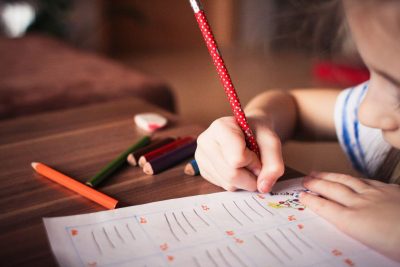Zip06 (Neag School alumnus Paul Freeman was named superintendent of the year by the Connecticut Association of Public School Superintendents)
Provost’s Distinguished Speaker Series Goes Virtual … and That’s a Good Thing
UConn Today (Sandra Chafouleas is featured about being a featured speaker)
Finding Joy Through the Holiday Season

Editor’s Note: The following originally appeared on Psychology Today, where Board of Trustees Distinguished Professor Sandra Chafouleas launched a new blog this past summer.
The typical holiday season can bring forth any number of emotions, from anger and sadness to joy and awe. Family traditions – those repeated and symbolically meaningful holiday rituals – play a big role in shaping your feelings throughout the season. Family traditions can buffer conflicts, boost positive feelings, and bring people closer together.
The pandemic is bringing an atypical holiday season this year, presenting change in the things we do, the way we do them, and who we do them with. We may miss out on getting together in person with family and friends, traveling to cherished places, or taking part in our traditional celebrations. Forced upon us, these unfamiliar changes can evoke feelings of loss and frustration.
As a very unfamiliar holiday season approaches, we can still find ways to bring familiarity and predictability — and the sense of comfort that goes with that — with some adaptations to our family traditions.
As a very unfamiliar holiday season approaches, we can still find ways to bring familiarity and predictability — and the sense of comfort that goes with that — with some adaptations to our family traditions.
Embrace that the holidays will be different.
Remember that “different” does not have to mean “awful.” It’s OK to feel disappointed about the loss of a traditional holiday season, but avoid labeling canceled celebrations as disasters. Acknowledge that different is just that — different — and that you have the ability to design opportunities that may not be exactly the same, but are familiar in ways that can evoke positive feelings and a sense of belonging.
Make a list of your typical holiday traditions.
Have each family member create a list of their favorite traditions. Tap into your senses about each tradition. What do you see, hear, smell, taste, and touch? Add details about what makes it special — when, where, how, and with whom it happens. Describe the feelings associated with each activity. One person might feel jolly contentment while baking with grandparents. Volunteering at a food pantry during the holidays may make the top of the list for someone else in fostering a sense of connectedness. Decorating the house might be how yet another family member happily expresses their creativity. Compare lists – look for overlap and differences in what brings forth positive feelings.
Get creative in adapting important traditions.
Go back through those lists of holiday traditions and consider a few that might not be missed too terribly this year. For those traditions that remain, be creative. Identify ways of adapting them to elicit the cheerful feelings and connectedness you’ve relished so much in the past. Make sure to include something from every person’s list.
For example, maybe everyone agrees that including a particular food item on the holiday menu is important, yet all are willing to forego baking for a game night or spiritual services. Emphasize holiday rituals that nurture a sense of being part of something bigger, such as volunteering, cooking, singing, decorating, and getting outside. And while it might not be possible to see family face to face, it is possible to come up with activities to learn about and connect to family history, such as recording stories or looking through photos. Even thinking or talking about cherished rituals can bring forth a sense of warmth and gratitude.
For ideas on how to adapt in consideration of the risk level associated with spreading the virus, check out the resources offered by the CDC.
Consider adapting traditions in ways that they can extend to before, during, and after the traditional holiday season, too. For example, a Virtual Thanksgiving might include sending a holiday care package with family favorites in advance, hosting a virtual shared meal, and sharing follow-up notes of appreciation.
Include simple rituals that bring a sustained sense of well-being.
Bigger is not always better when it comes to holiday activities. Simple rituals that foster connection are just as important to an overall sense of well-being. Look for activities that are easy to do, straightforward to understand, and can be seamlessly incorporated in your routine without lots of extra resources. Add a quick thankfulness activity in the daily routine, for example, such as sharing thoughts during mealtime or a walk, or using a journal to jot down notes of gratitude.
Perhaps most importantly, try to use these unfamiliar times to introduce a “less is more” perspective to the holiday season. Despite its challenges, this year might help us let go of expectations about what makes for the perfect holiday. Adapting familiar traditions for unfamiliar times can help us put in place the rituals that truly bring feelings of joy.
UConn Researchers Prepare Master’s Students to Work with Children with Developmental Disabilities

Editor’s Note: The following piece was originally published in UConn Today.
Many children with developmental disabilities, such as autism, have high-intensity behavioral needs, meaning they require a wide-ranging support system of people appropriately trained to work together to address their needs.
Nearly 400,000 students in Connecticut have special health care needs. In the past decade, the prevalence of children with developmental disabilities has increased by 17% and the prevalence of autism has increased by 300%. This has increased the demand for trained professionals to support students with high-intensity needs, which is additionally problematic given the national shortage of trained school psychologists and special educators.
A group of researchers from the University of Connecticut’s Neag School of Education and UConn School of Medicine have received a $1 million grant from the Office of Special Education Programs to develop training for master’s students to address this problem.
Professors Lisa Sanetti, Sandra Chafouleas, and Mary Beth Bruder have developed Interdisciplinary Preparation in Integrated and Intensive Practices (I3-PREP). The project is a multidisciplinary effort supported by UConn’s Institute for Collaboration on Health, Intervention, and Policy (InCHIP), the Neag School of Education, the UConn School of Medicine.
“I am honored to have the opportunity to lead this training initiative that will have positive impacts for our trainees and students with disabilities in Connecticut and beyond.”
— Professor Lisa Sanetti
This program will incorporate and extend interdisciplinary training provided by CT LEND (Leadership Education in Neurodevelopmental and Related Disabilities). CT LEND is directed by Bruder and is an interdisciplinary training program focused on improving the health, education, and social outcomes of children, youth, and adults with developmental disabilities and their families.
I3-PREP is based on an ecological model of development that views a child as being influenced by multiple interacting environments and relationships, such as those with their school, family, community, local politics, and broader culture. This program will provide advanced training in collaboration and coordination in using this model to provide a holistic, interdisciplinary approach to meeting the intensive needs of students with disabilities.
I3-PREP has three areas of emphasis: interdisciplinary coordination; an integrated whole-child approach; and intensive assessment and intervention.
Trainees will use an interprofessional lens for activities and interventions across the school, home, and community environments. This lens will ensure the child is supported by key personnel in every environment.
Trainees will learn how to integrate services that meet the child’s complex needs across the major areas of development: academic, social, emotional, behavioral, and physical. By considering all facets of a child’s well-being, they can succeed in the least-restrictive, most natural environments possible.
Advanced training in intensive assessment and intervention will enable trainees to appropriately identify a child’s needs across domains, and evaluate their responsiveness to high-quality and evidence-informed intervention plans.
The COVID-19 pandemic, which has forced many children to remote instruction since March, has emphasized the ways in which students with disabilities have not been adequately supported. This program will provide training for special educators and school psychologists that will enable them to serve students with high-intensity behavioral needs in any learning environment.
The two-year program will support two five-person cohorts of students from UConn’s accredited programs in school psychology and special education. The program will include coursework, clinical experience, and related activities. This interdisciplinary approach will provide students a robust knowledge base to better meet the needs of students with disabilities with high-intensity needs.
This intensive, well-rounded training program will provide graduate students with an invaluable opportunity to be prepared to engage throughout their careers in interdisciplinary work focused on meeting the integrated and intensive needs of students with developmental disabilities.
“School psychologists and special educators are uniquely qualified to lead coordinated, interdisciplinary, and holistic services for students with high-intensity needs,” says Lisa Sanetti, a professor of educational psychology in the Neag School of Education. “I am honored to have the opportunity to lead this training initiative that will have positive impacts for our trainees and students with disabilities in Connecticut and beyond.”
Finding Joy Through the Holiday Season
Psychology Today (Sandra Chafouleas pens commentary about ways for families to feel the familiar in unfamiliar times)
UConn Researchers Prepare Master’s Students to Work with Children with Developmental Disabilities
UConn Today (A new multi-disciplinary research project led by Lisa Sanetti, Sandra Chafouleas, and Mary Beth Bruder is featured)
Neag School Alumna Sets Up Planned Gift for Literacy Research
Editor’s Note: The following piece was originally published by the UConn Foundation.

Julie M. Wood ’71 (ED), ’72 MA is grateful for the safe haven that UConn gave her during the turbulent 1970s, and she recently began thinking about how she could give back.
Wood (’99 Ph.D. Harvard), a renowned educational consultant, decided to leave a planned gift to UConn to support research in an area close to her heart: children’s literacy. She has set up an endowment that will generate funding every year for a faculty member in the Neag School of Education to conduct research in effective practices to support children’s literacy development.
Wood has devoted her life to developing literacy in young children. An international consultant, she worked with publishers to develop textbooks, curricula, and technology programs to help all children succeed, especially those in underserved communities.
“The older I got, the more I thought in terms of a legacy and really leaving something to the next generation.”
— Julie M. Wood ’71 (ED), ’72 MA
She was pleased when UConn President Tom Katsouleas announced that his goal was to double research efforts at UConn. She hopes her gift will help bring even greater respect and visibility to the Neag School.
She said the UConn Foundation staff worked closely with her to create a planned gift that would feel right for her. It was easy to set it up and satisfying to leave everything in place and to think about it for the future, she said.
“The older I got, the more I thought in terms of a legacy and really leaving something to the next generation,” she said. “For me, I can’t think of a better cause because I do believe so strongly in education and believe in Neag Dean Gladis Kersaint.”
When Wood attended UConn in the early ’70s, she and other students were facing down a recession, the Vietnam War, and turbulent social unrest.
“I felt that UConn had just saved me,” she said. “It was my intellectual base, my haven, during a very stressful time in our nation—with many parallels to today,” she said. “I found the faculty very inspiring and supportive.”
After graduating and earning a master’s degree from UConn, Wood worked for 11 years as a literacy specialist and fourth-grade teacher in Amherst, N.H. Then she became involved in educational publishing and, eventually, media development, creating videos for children.
She also taught as an adjunct professor at Harvard’s Graduate School of Education, where she earned a master’s degree in education in 1992 and a doctorate in 1999. She now consults from her home office in Cambridge, Mass., where she lives with her husband, John, a retired scientist.
“We are moved by and indebted to Julie for this gift, as well as for her heartfelt support these past few years as a member of our Neag School Board of Advocates,” says Dean Gladis Kersaint. “Champions like Julie remain so crucial to our faculty scholars as they take on new and forward-thinking research efforts in education while launching a path for the next generation of innovative educators, school leaders, and sport management professionals.”
Neag Alumna Sets Up Planned Gift for Literacy Research
UConn Foundation (Neag School alumna Julie Wood is featured about her planned gift to support children’s literacy research)
Women Need a Sisterhood: Finding More Success By Supporting Each Other
Forbes (Research co-authored by Neag School doctoral student Kristi Kaeppel and Robin S. Grenier is referenced)
Identifying Dyslexia Early
UConn Today (Video: A game-like app that helps identify dyslexia early, co-developed by Devin Kearns, is featured)
